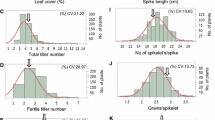Summary
Populations of wild emmer wheat, Triticum dicoccoides, in Israel, originating from diverse habitats, and tested earlier for allozyme (Nevo et al., 1982) and disease resistance polymorphisms (Moseman et al., 1983a, 1983b; Nevo et al., 1984a, 1984b), were compared and contrasted for performance in agronomically important phenotypic traits. The traits compared involved 10 variables comparing germination, earliness, biomass and yield variables. The field experiments were conducted in 1980, 1981 and 1982 in two relatively standardized and contrasting environments: mesic (Mount Carmel, Haifa) and xeric (Acedat Farm, and Sede Boqer, in the northern Negev desert). The experimental design involved 12 population quadrangles at Avedat Farm in 1980, and rows of randomized genotypes of five populations in both Haifa and Sede Boqer in 1981 and 1982.
The results indicate that the characters studied are partly genetically determined. Striking genetic variation was found between and, at least in some characters, also within populations in each site, whereas remarkable environmental variation including genetic-environmental interaction was found between the mesic and the xeric sites. We conclude that natural populations of wild emmer wheat in Israel vary not only in genetic polymorphisms of allozymes and disease resistance, but also in quantitative traits of agronomic importance. These traits are economically significant and should be conserved and utilized in wheat crop improvement.
Similar content being viewed by others
References
Atlas of Israel, 1970. Survey of Israel, Jerusalem: Ministry of Labour. Amsterdam: Elsevier Pub. Co.
Evenari M., L. Shanan & N. Tadmor, 1971. The Negev. The challenge of a desert. Cambridge: Harvard University Press.
Feldman M. & E. R. Sears, 1981. The wild gene resources of wheat. Sci. Amer. 244: 102–112.
Frankel O. H. & E. Bennett, 1970. Genetic resources in plants-their exploration and conservation. Oxford: Blackwell Pub.
Frankel O. H. & M. Soulé, 1981. Conservation and evolution. Cambridge: Cambridge University Press.
Gerechter-Amitai Z. K. & A. Grama, 1974. Inheritance of resistance to stripe rust (Puccinia striiformis) in crosses between wild emmer (Triticum dicocciodes) and cultivated tetraploid and hexaploid wheat. I. Triticum durum. Euphytica 23: 387–392.
Gerechter-Amitai Z. K. & A. Grama, 1977. Use of alien genes in wheat breeding. Ann. Wheat Newsl. 23: 57–58.
Grama A. & Z. K. Gerechter-Amitai, 1974. Inheritance of resistance to stripe rust (Puccinia striiformis) in crosses between wild emmer (Triticum dicoccoides) and cultivated tetraploid and hexaploid wheats. II. Triticum aestivum. Euphytica 23: 393–398.
Grama, A., Z. K. Gerechter-Amitai, A. Blum & G. L. Rubenthaler, 1983. Breeding bread wheat cultivars for high protein content by transfer of protein genes from Triticum dicoccoides Proc. Intern. Atomic Energy Ag. (in press).
Harlan J. R., J. M. J.de Wet & E. G. Price, 1973. Comparative evolution of cereals. Evolution 27: 311–325.
Moseman, J. G., E. Nevo & D. Zohary. 1984a. Resistance of Hordeum spontaneum collected in Israel to infection with Erysiphe graminis hordei. Euphytica (in press).
Moseman, J. G., E. Nevo, M. A. El-Morshidy & D. Zohary, 1984b. Resistance of Triticum dicoccoides collected in Israel to infection with Puccinia recondita tritici. Crop Sci. (in press).
Nevo E., D. Zohary, A. H. D. Brown & M. Haber, 1979. Genetic diversity and environmental associations of wild barley, Hordeum spontaneum in Israel. Evolution 33: 815–833.
Nevo E., E. M. Golenberg, A. Beiles, A. H. D. Brown & D. Zohary, 1982. Genetic diversity and environmental associations of wild wheat Triticum dicoccoides, in Israel. Theor. Appl. Genet 62: 241–254.
Nevo, E., J. G. Moseman, A. Beiles & D. Zohary, 1984a. Patterns of resistance of wild wheat to pathogens in Israel: Predictive method by ecology and allozyme genotypes. (submitted).
Nevo, E., Z. K. Gerechter-Amitai, A. Beiles & E. M. Golenberg, 1984b. Patterns of disease resistance of wild wheat in Israel: II. Predictive method by ecology and allozyme genotypes for stripe rust. (submitted).
Plucknett D. L., N. J. H. Smith, J. T. Williams & N. M. Anishetty, 1983. Crop germplasm conservation and developing countries. Science 220: 163–169.
SPSSx. 1983. User's guide. New York: McGraw Hill Co.
Zohary D, 1970. Wild wheats. In: O. H. Frankel & E. Bennett (Eds), Genetic resources in plants—their exploration and conservation. pp. 239–247. Oxford: Blackwell Pub.
Author information
Authors and Affiliations
Rights and permissions
About this article
Cite this article
Nevo, E., Beiles, A., Gutterman, Y. et al. Genetic resources of wild cereals in Israel and vicinity. I. Phenotypic variation within and between populations of wild wheat, Triticum dicoccoides . Euphytica 33, 717–735 (1984). https://doi.org/10.1007/BF00021900
Received:
Issue Date:
DOI: https://doi.org/10.1007/BF00021900




